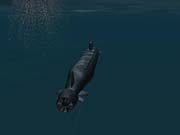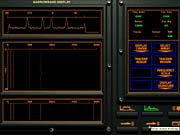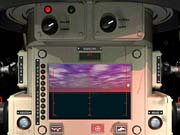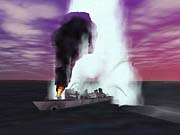Sub Command is the kind of game most publishers would be afraid to release. It is ambitious, complex, difficult to learn, and slavishly devoted to realism. You spend most of your time looking at control panels and wondering what's out there. There's a lot of waiting and guessing. The average gamer would hate it--but Sub Command isn't for the average gamer. It is a sophisticated simulation for people who like their sims sophisticated. If you're a hard-core simmer--the kind of person who revels in a meaty manual, who thinks relaxed realism settings just teach bad habits, and who scoffs at putting a 3D engine in Harpoon because you'll only be using NATO symbology anyway--then Sub Command has your name written all over it.

Sub Command was created by Sonalysts as a follow-up to its last submarine sim, Jane's 688(I) Hunter/Killer. 688(I) was easily the most realistic contemporary sub sim when it was released, but it was criticized for having canned scenarios and a linear campaign. Sub Command continues this trend, but there's more variability in the scenarios. Also, the campaign missions are interrelated, so your performance in one mission will have an effect on the setup of the next mission. It's not a dynamic campaign per se, but there's a sense of continuity. Since you can play the campaign and most of the scenarios from the US or the Russian side, there's more replayability than there was in 688(I). Furthermore, there's a comprehensive scenario editor, so expect to see plenty of player-made scenarios on the Internet.
The most immediate difference from 688(I) is that Sub Command lets you control your choice of four different subs: the 688(I) improved Los Angeles class, the next-generation Seawolf, or one of two variants of Russia's bulbous Akula. The controls range from the Seawolf's sleek touch displays and the 688's smartly military panels to the Akula's clunky spread of tickers, switches, knobs, and cranks. From the inside, these subs have a tremendous amount of personality. There are also differences in their weapon loadouts and sonar suites. However, it's hard to tell how much they differ in capability. The Akula and Seawolf are light-years apart in terms of technology. The Seawolf should be so quiet that it can cruise at relatively high speeds with little risk of detection, and the Akula should be a noisy clunker in comparison. But there's no indication of these differences in the game or manual.

Sub Command's manual is a 208-page Adobe Acrobat file. Be sure you've got a printer with plenty of toner, or about 15 bucks to print it out at the local Kinko's. Even then, the manual is only slightly helpful. It does a good job of explaining how you do things, but doesn't offer a whit of advice for why you should do things. There's no information on avoiding detection, evading incoming torpedoes, or how to best use your sensors. It's as if Sonalysts expects you to already know what you're supposed to do once you're in charge of a nuclear submarine. This makes the game's steep learning curve even steeper. There are three short tutorials that offer only basic information before suddenly ending, leaving you with more questions than answers. It's insulting enough that EA doesn't offer a printed manual; it's just pouring salt in the wound that such a big manual contains so little helpful information.
Once you get the hang of it, Sub Command is basically a hide-and-seek game with advanced electronics. In a contemporary sub, you're more of a high-tech detective than a warrior. Instead of fighting a battle, you're solving a mystery. Who's out there? Where exactly are they? Where are they going? Have they heard me? Should I shoot at them? You're putting together pieces of a puzzle, one shred of evidence at a time. Through patience and careful analysis, you draw conclusions and act accordingly.
For instance, it takes several steps to figure out that a Russian destroyer is five miles away, moving across your bow at 10 knots. First you hear the sound and match its frequency against a database of vessels. Then you figure out its speed by demodulating the sound of its propeller to count the number of blades and calculate how fast they're turning. Cross-reference that number with known data about that ship type and you can estimate its speed. Over time, you'll plot a series of bearings. Once you figure in the vessel's speed and compare it with these bearings, you can triangulate its range. This is how you eventually make an informed guess about where the ship is.

To many people, this will sound tedious. It is slow and it requires a lot of patience. But if you can appreciate the tension inherent in high-tech warfare--and if you're willing to wade through a lot of trial and error to make up for the manual's shortcomings--then Sub Command is a true delight. There's something uniquely gratifying about everything coming together just right when you successfully manage to put a torpedo on its target. This sim doesn't shy away from presenting the methodical business of submarine warfare in all its detailed glory. It takes work, but it pays off.
Jane's 688(I) had a full 3D view of the action. Sub Command offers this, but only as a representation of what you think is out there. For instance, if you pick up a sonar contact, it appears as a wireframe sphere at the estimated location. Perhaps you'll determine it's a surface contact, at which point it takes on the appearance of a generic ship. When you then determine the specific type of ship, it takes on the appearance of that vessel. But this model is only a representation of your best guess. In reality, it may not be the ship you think it is. It may not even be there. Sub Command uses its 3D engine as a visual supplement instead of a cheat. It adds a nice touch of eye candy to a game that would otherwise consist solely of control panels.
Another nice touch is the use of voice commands to drive the sub and perform higher-level functions. You can turn over the sonar and weapon control stations to computer-controlled crewmen and use a microphone to coordinate everything. However, the voice recognition, supplied by Microsoft, isn't very fast or reliable.

One thing conspicuously absent from the game is damage control. Just as any flight sim player revels in the prospect of landing a damaged bird, wrestling to keep a flooded sub from sinking should be part of any submarine sim. But modern-day weapons are more lethal than World War II-era depth charges. If the first hit from a torpedo doesn't kill you, you'll probably be rendered so blind and noisy by the damage that the coup de grace is a mere formality. Perhaps this is why Sub Command didn't bother to include damage control. Instead, your sub's "hit points" are represented by a health bar that looks like something from a first-person shooter. This is particularly silly considering the level of realism in the rest of Sub Command.
On the whole, Sub Command is one of those rare and delicious projects that's 90 percent simulation and 10 percent game. Although it may be the last of a dying breed--it's hard to imagine Sub Command being commercially successful--it is heaven-sent. It's a latter-day throwback to the sort of sims released by MicroProse in its heyday. Electronic Arts should be applauded for releasing a product with such limited appeal without dumbing it down. If there's a next time, here's to hoping there's a better manual to go with it.